Financial Structure of Healthcare Systems Comparison Report
VerifiedAdded on 2022/11/13
|13
|2666
|207
Report
AI Summary
This report provides a comparative analysis of healthcare financial management in Australia, the United States, and New Zealand. It examines the financial structures, expenditure patterns, and performance of each country's healthcare system, focusing on the period from 2000 to 2010. The study highlights disparities in healthcare spending relative to GDP, life expectancy, and access to care, particularly in Australia. The report includes tables and figures illustrating trends in healthcare expenditure and purchasing power parity. It also identifies financial challenges such as inefficient insurance policies, regional disparities, and economic factors, offering recommendations for improvements in the Australian healthcare system. These recommendations include financial strategies like enhanced governmental revenue and effective insurance policies, as well as social aspects such as healthcare awareness programs and mitigation of regional disparities. The report concludes with a summary of the key findings and emphasizes the need for comprehensive actions to improve healthcare outcomes.
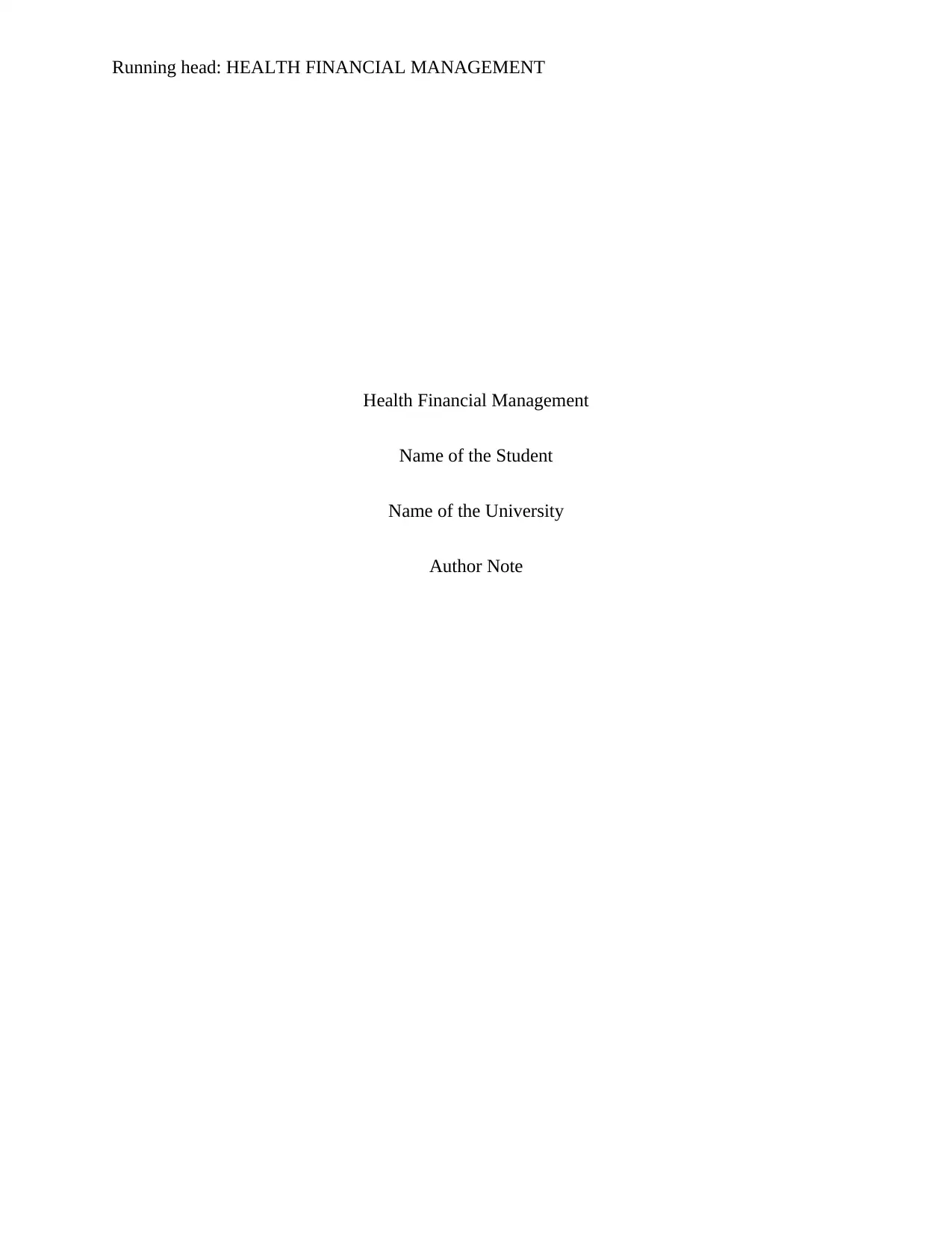
Running head: HEALTH FINANCIAL MANAGEMENT
Health Financial Management
Name of the Student
Name of the University
Author Note
Health Financial Management
Name of the Student
Name of the University
Author Note
Paraphrase This Document
Need a fresh take? Get an instant paraphrase of this document with our AI Paraphraser
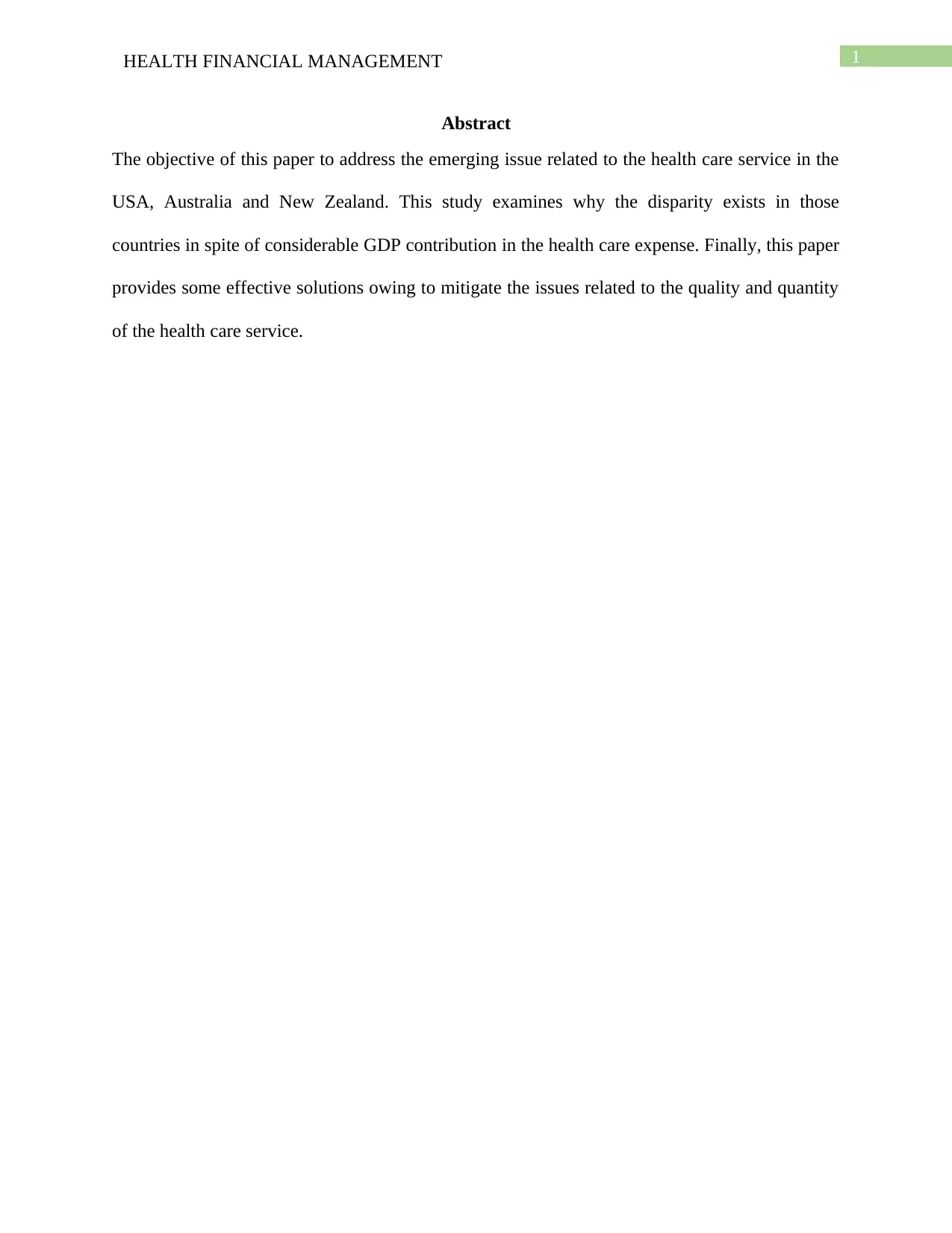
1HEALTH FINANCIAL MANAGEMENT
Abstract
The objective of this paper to address the emerging issue related to the health care service in the
USA, Australia and New Zealand. This study examines why the disparity exists in those
countries in spite of considerable GDP contribution in the health care expense. Finally, this paper
provides some effective solutions owing to mitigate the issues related to the quality and quantity
of the health care service.
Abstract
The objective of this paper to address the emerging issue related to the health care service in the
USA, Australia and New Zealand. This study examines why the disparity exists in those
countries in spite of considerable GDP contribution in the health care expense. Finally, this paper
provides some effective solutions owing to mitigate the issues related to the quality and quantity
of the health care service.
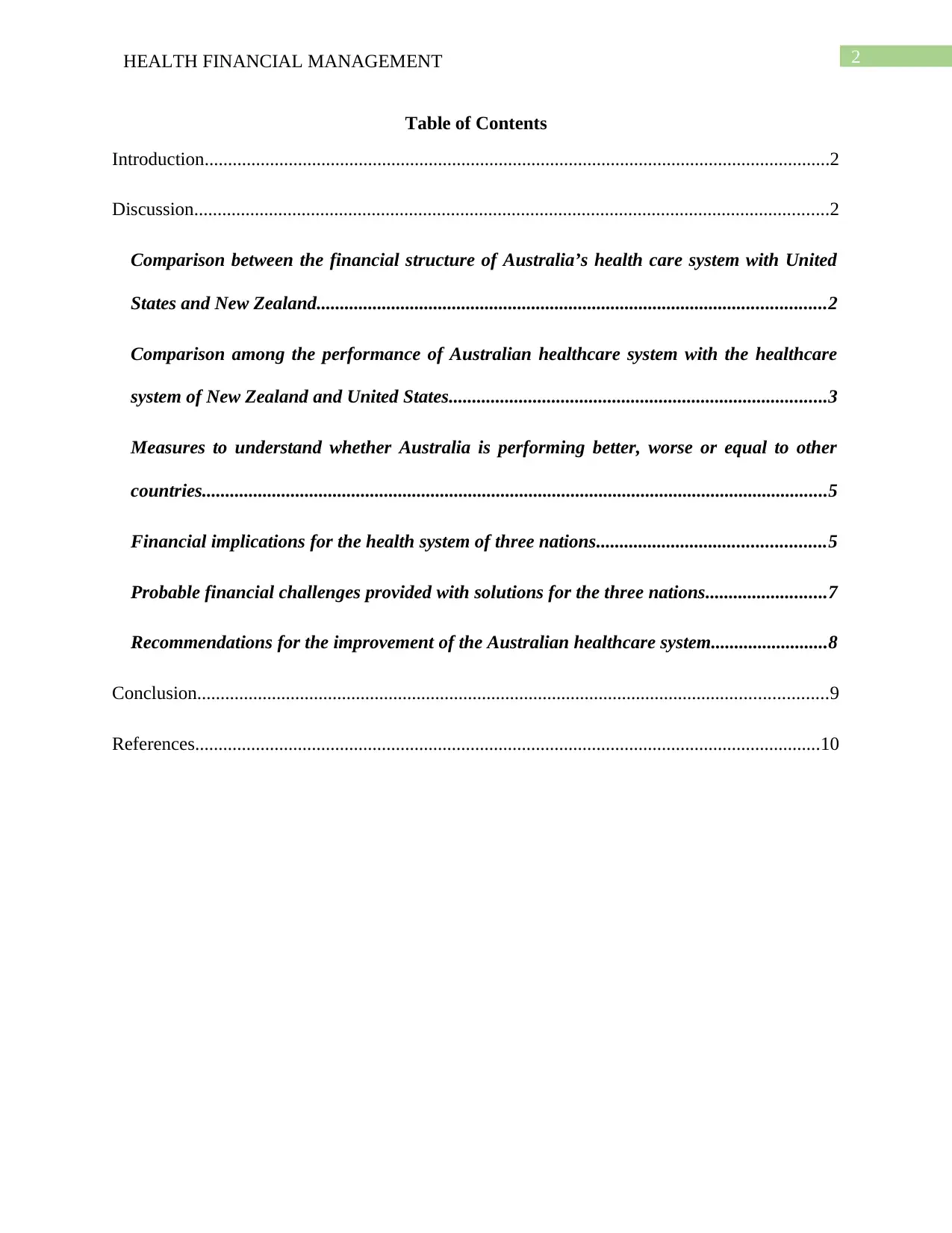
2HEALTH FINANCIAL MANAGEMENT
Table of Contents
Introduction......................................................................................................................................2
Discussion........................................................................................................................................2
Comparison between the financial structure of Australia’s health care system with United
States and New Zealand.............................................................................................................2
Comparison among the performance of Australian healthcare system with the healthcare
system of New Zealand and United States.................................................................................3
Measures to understand whether Australia is performing better, worse or equal to other
countries......................................................................................................................................5
Financial implications for the health system of three nations.................................................5
Probable financial challenges provided with solutions for the three nations..........................7
Recommendations for the improvement of the Australian healthcare system.........................8
Conclusion.......................................................................................................................................9
References......................................................................................................................................10
Table of Contents
Introduction......................................................................................................................................2
Discussion........................................................................................................................................2
Comparison between the financial structure of Australia’s health care system with United
States and New Zealand.............................................................................................................2
Comparison among the performance of Australian healthcare system with the healthcare
system of New Zealand and United States.................................................................................3
Measures to understand whether Australia is performing better, worse or equal to other
countries......................................................................................................................................5
Financial implications for the health system of three nations.................................................5
Probable financial challenges provided with solutions for the three nations..........................7
Recommendations for the improvement of the Australian healthcare system.........................8
Conclusion.......................................................................................................................................9
References......................................................................................................................................10
⊘ This is a preview!⊘
Do you want full access?
Subscribe today to unlock all pages.

Trusted by 1+ million students worldwide
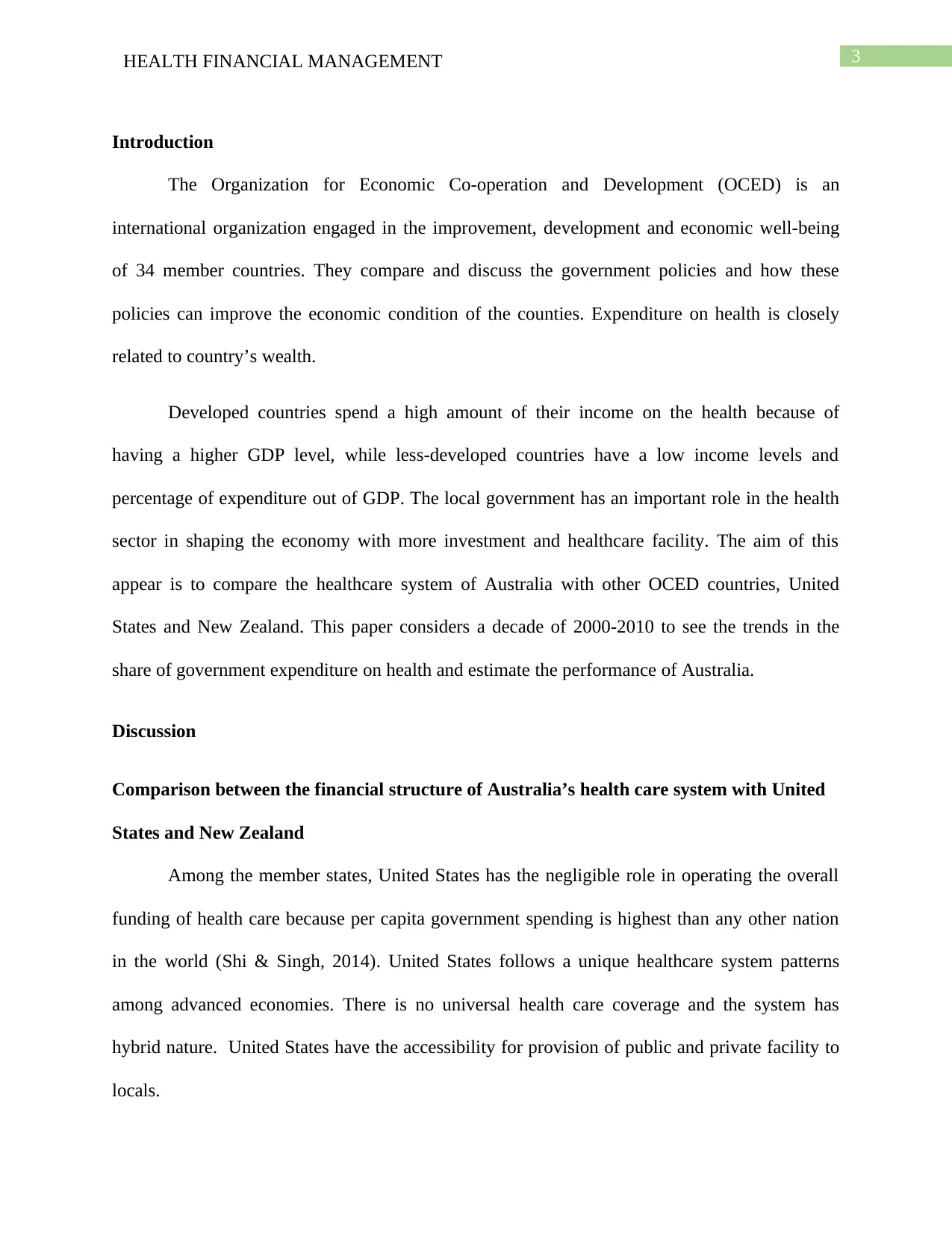
3HEALTH FINANCIAL MANAGEMENT
Introduction
The Organization for Economic Co-operation and Development (OCED) is an
international organization engaged in the improvement, development and economic well-being
of 34 member countries. They compare and discuss the government policies and how these
policies can improve the economic condition of the counties. Expenditure on health is closely
related to country’s wealth.
Developed countries spend a high amount of their income on the health because of
having a higher GDP level, while less-developed countries have a low income levels and
percentage of expenditure out of GDP. The local government has an important role in the health
sector in shaping the economy with more investment and healthcare facility. The aim of this
appear is to compare the healthcare system of Australia with other OCED countries, United
States and New Zealand. This paper considers a decade of 2000-2010 to see the trends in the
share of government expenditure on health and estimate the performance of Australia.
Discussion
Comparison between the financial structure of Australia’s health care system with United
States and New Zealand
Among the member states, United States has the negligible role in operating the overall
funding of health care because per capita government spending is highest than any other nation
in the world (Shi & Singh, 2014). United States follows a unique healthcare system patterns
among advanced economies. There is no universal health care coverage and the system has
hybrid nature. United States have the accessibility for provision of public and private facility to
locals.
Introduction
The Organization for Economic Co-operation and Development (OCED) is an
international organization engaged in the improvement, development and economic well-being
of 34 member countries. They compare and discuss the government policies and how these
policies can improve the economic condition of the counties. Expenditure on health is closely
related to country’s wealth.
Developed countries spend a high amount of their income on the health because of
having a higher GDP level, while less-developed countries have a low income levels and
percentage of expenditure out of GDP. The local government has an important role in the health
sector in shaping the economy with more investment and healthcare facility. The aim of this
appear is to compare the healthcare system of Australia with other OCED countries, United
States and New Zealand. This paper considers a decade of 2000-2010 to see the trends in the
share of government expenditure on health and estimate the performance of Australia.
Discussion
Comparison between the financial structure of Australia’s health care system with United
States and New Zealand
Among the member states, United States has the negligible role in operating the overall
funding of health care because per capita government spending is highest than any other nation
in the world (Shi & Singh, 2014). United States follows a unique healthcare system patterns
among advanced economies. There is no universal health care coverage and the system has
hybrid nature. United States have the accessibility for provision of public and private facility to
locals.
Paraphrase This Document
Need a fresh take? Get an instant paraphrase of this document with our AI Paraphraser
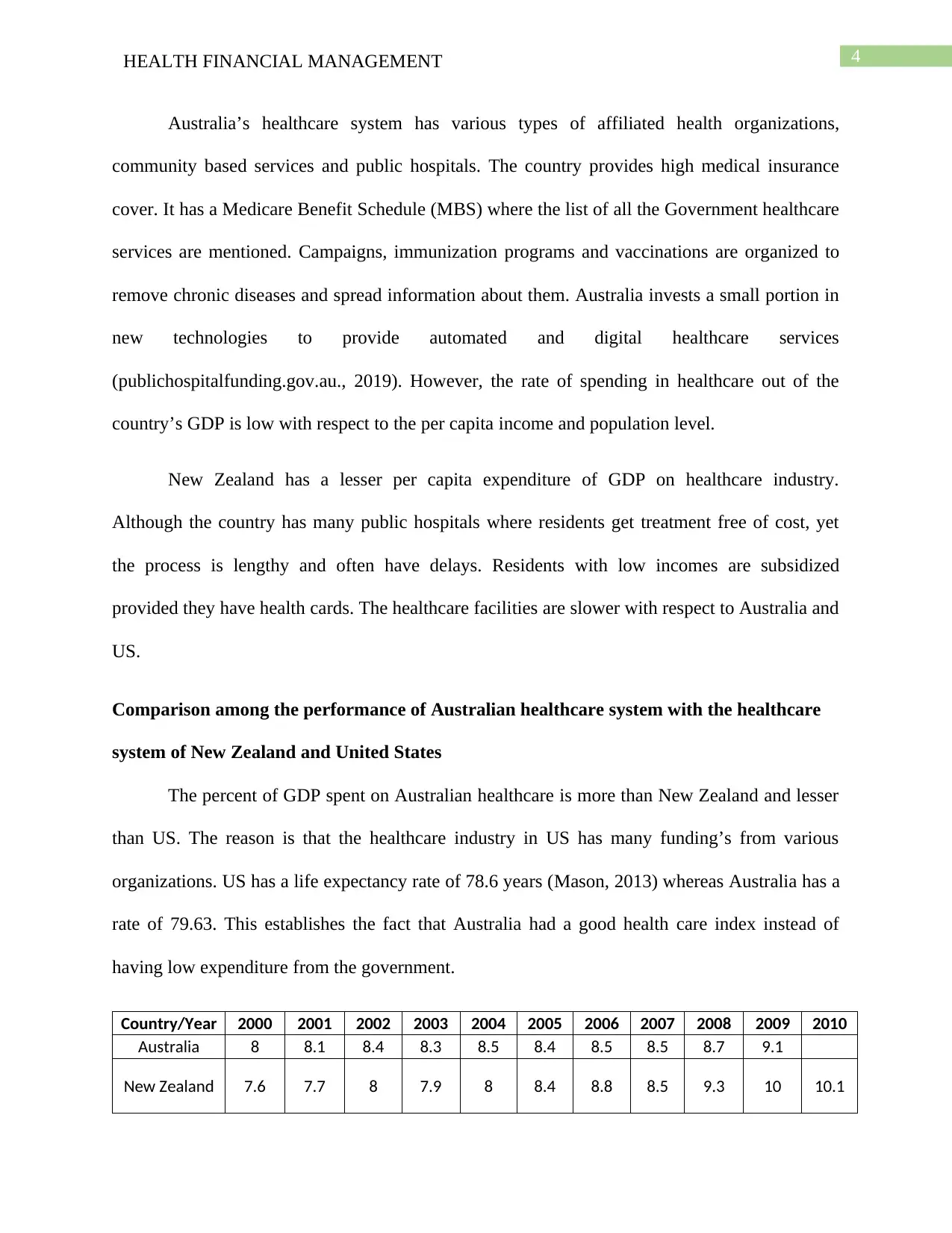
4HEALTH FINANCIAL MANAGEMENT
Australia’s healthcare system has various types of affiliated health organizations,
community based services and public hospitals. The country provides high medical insurance
cover. It has a Medicare Benefit Schedule (MBS) where the list of all the Government healthcare
services are mentioned. Campaigns, immunization programs and vaccinations are organized to
remove chronic diseases and spread information about them. Australia invests a small portion in
new technologies to provide automated and digital healthcare services
(publichospitalfunding.gov.au., 2019). However, the rate of spending in healthcare out of the
country’s GDP is low with respect to the per capita income and population level.
New Zealand has a lesser per capita expenditure of GDP on healthcare industry.
Although the country has many public hospitals where residents get treatment free of cost, yet
the process is lengthy and often have delays. Residents with low incomes are subsidized
provided they have health cards. The healthcare facilities are slower with respect to Australia and
US.
Comparison among the performance of Australian healthcare system with the healthcare
system of New Zealand and United States
The percent of GDP spent on Australian healthcare is more than New Zealand and lesser
than US. The reason is that the healthcare industry in US has many funding’s from various
organizations. US has a life expectancy rate of 78.6 years (Mason, 2013) whereas Australia has a
rate of 79.63. This establishes the fact that Australia had a good health care index instead of
having low expenditure from the government.
Country/Year 2000 2001 2002 2003 2004 2005 2006 2007 2008 2009 2010
Australia 8 8.1 8.4 8.3 8.5 8.4 8.5 8.5 8.7 9.1
New Zealand 7.6 7.7 8 7.9 8 8.4 8.8 8.5 9.3 10 10.1
Australia’s healthcare system has various types of affiliated health organizations,
community based services and public hospitals. The country provides high medical insurance
cover. It has a Medicare Benefit Schedule (MBS) where the list of all the Government healthcare
services are mentioned. Campaigns, immunization programs and vaccinations are organized to
remove chronic diseases and spread information about them. Australia invests a small portion in
new technologies to provide automated and digital healthcare services
(publichospitalfunding.gov.au., 2019). However, the rate of spending in healthcare out of the
country’s GDP is low with respect to the per capita income and population level.
New Zealand has a lesser per capita expenditure of GDP on healthcare industry.
Although the country has many public hospitals where residents get treatment free of cost, yet
the process is lengthy and often have delays. Residents with low incomes are subsidized
provided they have health cards. The healthcare facilities are slower with respect to Australia and
US.
Comparison among the performance of Australian healthcare system with the healthcare
system of New Zealand and United States
The percent of GDP spent on Australian healthcare is more than New Zealand and lesser
than US. The reason is that the healthcare industry in US has many funding’s from various
organizations. US has a life expectancy rate of 78.6 years (Mason, 2013) whereas Australia has a
rate of 79.63. This establishes the fact that Australia had a good health care index instead of
having low expenditure from the government.
Country/Year 2000 2001 2002 2003 2004 2005 2006 2007 2008 2009 2010
Australia 8 8.1 8.4 8.3 8.5 8.4 8.5 8.5 8.7 9.1
New Zealand 7.6 7.7 8 7.9 8 8.4 8.8 8.5 9.3 10 10.1
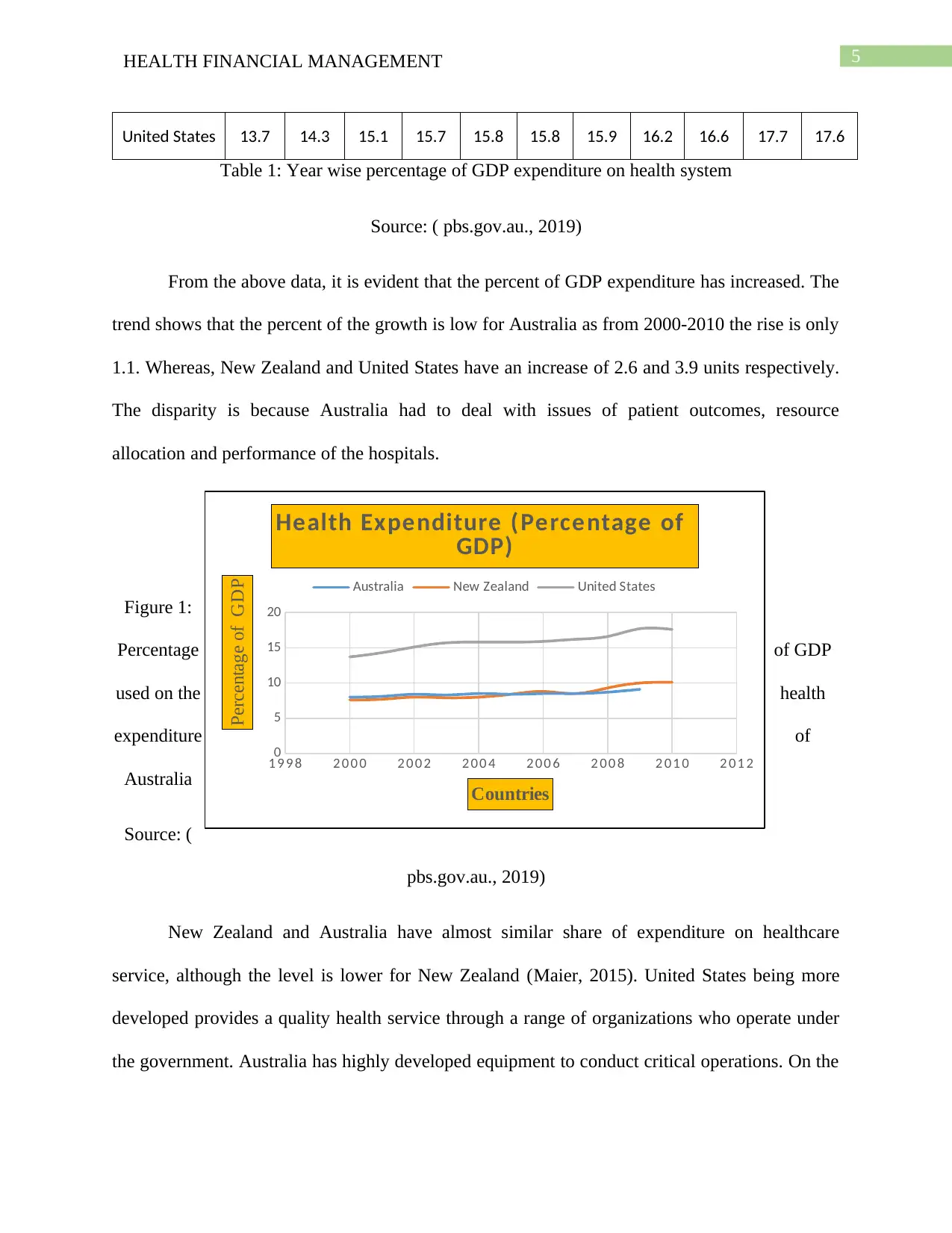
5HEALTH FINANCIAL MANAGEMENT
United States 13.7 14.3 15.1 15.7 15.8 15.8 15.9 16.2 16.6 17.7 17.6
Table 1: Year wise percentage of GDP expenditure on health system
Source: ( pbs.gov.au., 2019)
From the above data, it is evident that the percent of GDP expenditure has increased. The
trend shows that the percent of the growth is low for Australia as from 2000-2010 the rise is only
1.1. Whereas, New Zealand and United States have an increase of 2.6 and 3.9 units respectively.
The disparity is because Australia had to deal with issues of patient outcomes, resource
allocation and performance of the hospitals.
Figure 1:
Percentage of GDP
used on the health
expenditure of
Australia
Source: (
pbs.gov.au., 2019)
New Zealand and Australia have almost similar share of expenditure on healthcare
service, although the level is lower for New Zealand (Maier, 2015). United States being more
developed provides a quality health service through a range of organizations who operate under
the government. Australia has highly developed equipment to conduct critical operations. On the
1 9 9 8 2 0 0 0 2 0 0 2 2 0 0 4 2 0 0 6 2 0 0 8 2 0 1 0 2 0 1 2
0
5
10
15
20
Health Expenditure (Percentage of
GDP)
Australia New Zealand United States
Countries
Percentage of GDP
United States 13.7 14.3 15.1 15.7 15.8 15.8 15.9 16.2 16.6 17.7 17.6
Table 1: Year wise percentage of GDP expenditure on health system
Source: ( pbs.gov.au., 2019)
From the above data, it is evident that the percent of GDP expenditure has increased. The
trend shows that the percent of the growth is low for Australia as from 2000-2010 the rise is only
1.1. Whereas, New Zealand and United States have an increase of 2.6 and 3.9 units respectively.
The disparity is because Australia had to deal with issues of patient outcomes, resource
allocation and performance of the hospitals.
Figure 1:
Percentage of GDP
used on the health
expenditure of
Australia
Source: (
pbs.gov.au., 2019)
New Zealand and Australia have almost similar share of expenditure on healthcare
service, although the level is lower for New Zealand (Maier, 2015). United States being more
developed provides a quality health service through a range of organizations who operate under
the government. Australia has highly developed equipment to conduct critical operations. On the
1 9 9 8 2 0 0 0 2 0 0 2 2 0 0 4 2 0 0 6 2 0 0 8 2 0 1 0 2 0 1 2
0
5
10
15
20
Health Expenditure (Percentage of
GDP)
Australia New Zealand United States
Countries
Percentage of GDP
⊘ This is a preview!⊘
Do you want full access?
Subscribe today to unlock all pages.

Trusted by 1+ million students worldwide
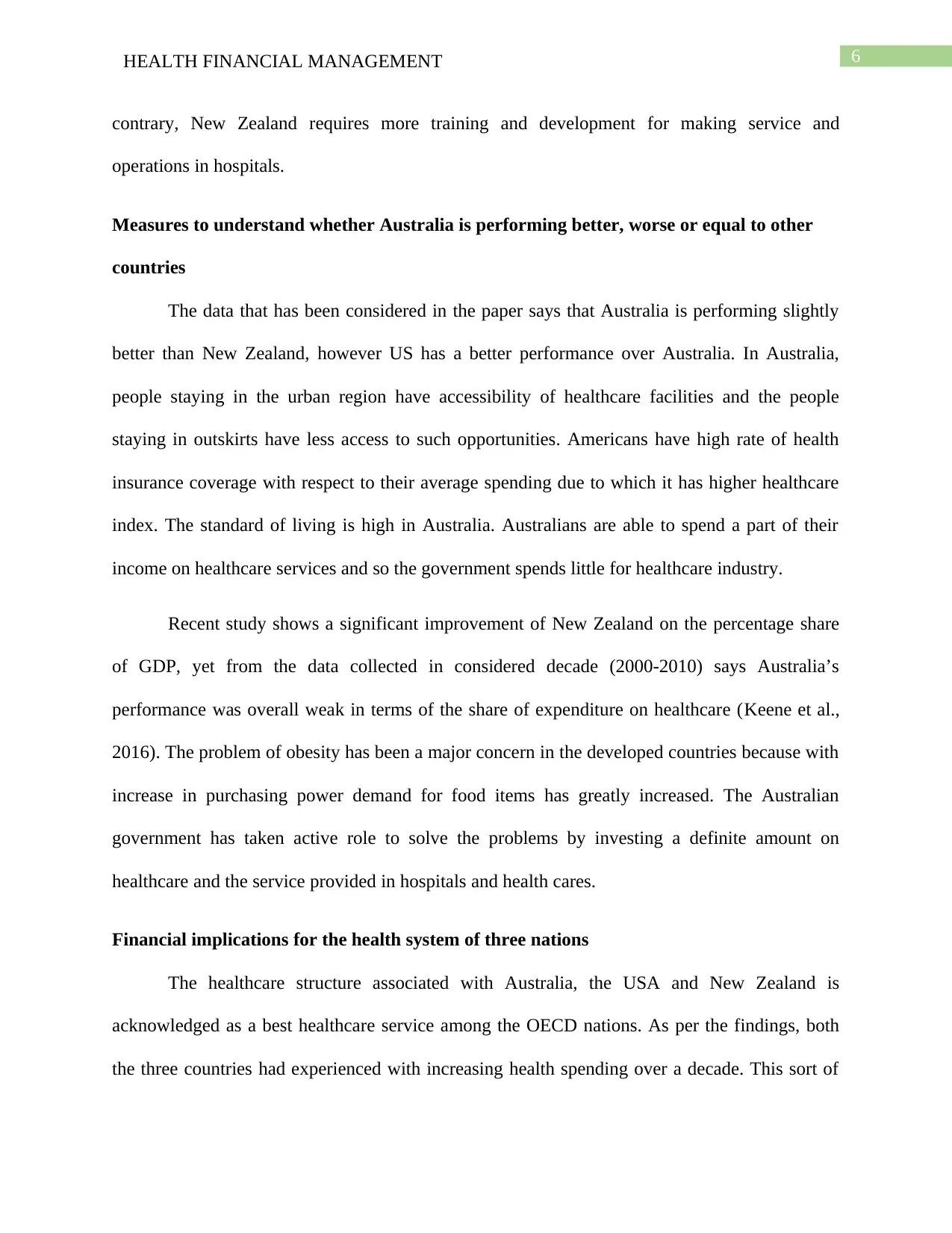
6HEALTH FINANCIAL MANAGEMENT
contrary, New Zealand requires more training and development for making service and
operations in hospitals.
Measures to understand whether Australia is performing better, worse or equal to other
countries
The data that has been considered in the paper says that Australia is performing slightly
better than New Zealand, however US has a better performance over Australia. In Australia,
people staying in the urban region have accessibility of healthcare facilities and the people
staying in outskirts have less access to such opportunities. Americans have high rate of health
insurance coverage with respect to their average spending due to which it has higher healthcare
index. The standard of living is high in Australia. Australians are able to spend a part of their
income on healthcare services and so the government spends little for healthcare industry.
Recent study shows a significant improvement of New Zealand on the percentage share
of GDP, yet from the data collected in considered decade (2000-2010) says Australia’s
performance was overall weak in terms of the share of expenditure on healthcare (Keene et al.,
2016). The problem of obesity has been a major concern in the developed countries because with
increase in purchasing power demand for food items has greatly increased. The Australian
government has taken active role to solve the problems by investing a definite amount on
healthcare and the service provided in hospitals and health cares.
Financial implications for the health system of three nations
The healthcare structure associated with Australia, the USA and New Zealand is
acknowledged as a best healthcare service among the OECD nations. As per the findings, both
the three countries had experienced with increasing health spending over a decade. This sort of
contrary, New Zealand requires more training and development for making service and
operations in hospitals.
Measures to understand whether Australia is performing better, worse or equal to other
countries
The data that has been considered in the paper says that Australia is performing slightly
better than New Zealand, however US has a better performance over Australia. In Australia,
people staying in the urban region have accessibility of healthcare facilities and the people
staying in outskirts have less access to such opportunities. Americans have high rate of health
insurance coverage with respect to their average spending due to which it has higher healthcare
index. The standard of living is high in Australia. Australians are able to spend a part of their
income on healthcare services and so the government spends little for healthcare industry.
Recent study shows a significant improvement of New Zealand on the percentage share
of GDP, yet from the data collected in considered decade (2000-2010) says Australia’s
performance was overall weak in terms of the share of expenditure on healthcare (Keene et al.,
2016). The problem of obesity has been a major concern in the developed countries because with
increase in purchasing power demand for food items has greatly increased. The Australian
government has taken active role to solve the problems by investing a definite amount on
healthcare and the service provided in hospitals and health cares.
Financial implications for the health system of three nations
The healthcare structure associated with Australia, the USA and New Zealand is
acknowledged as a best healthcare service among the OECD nations. As per the findings, both
the three countries had experienced with increasing health spending over a decade. This sort of
Paraphrase This Document
Need a fresh take? Get an instant paraphrase of this document with our AI Paraphraser
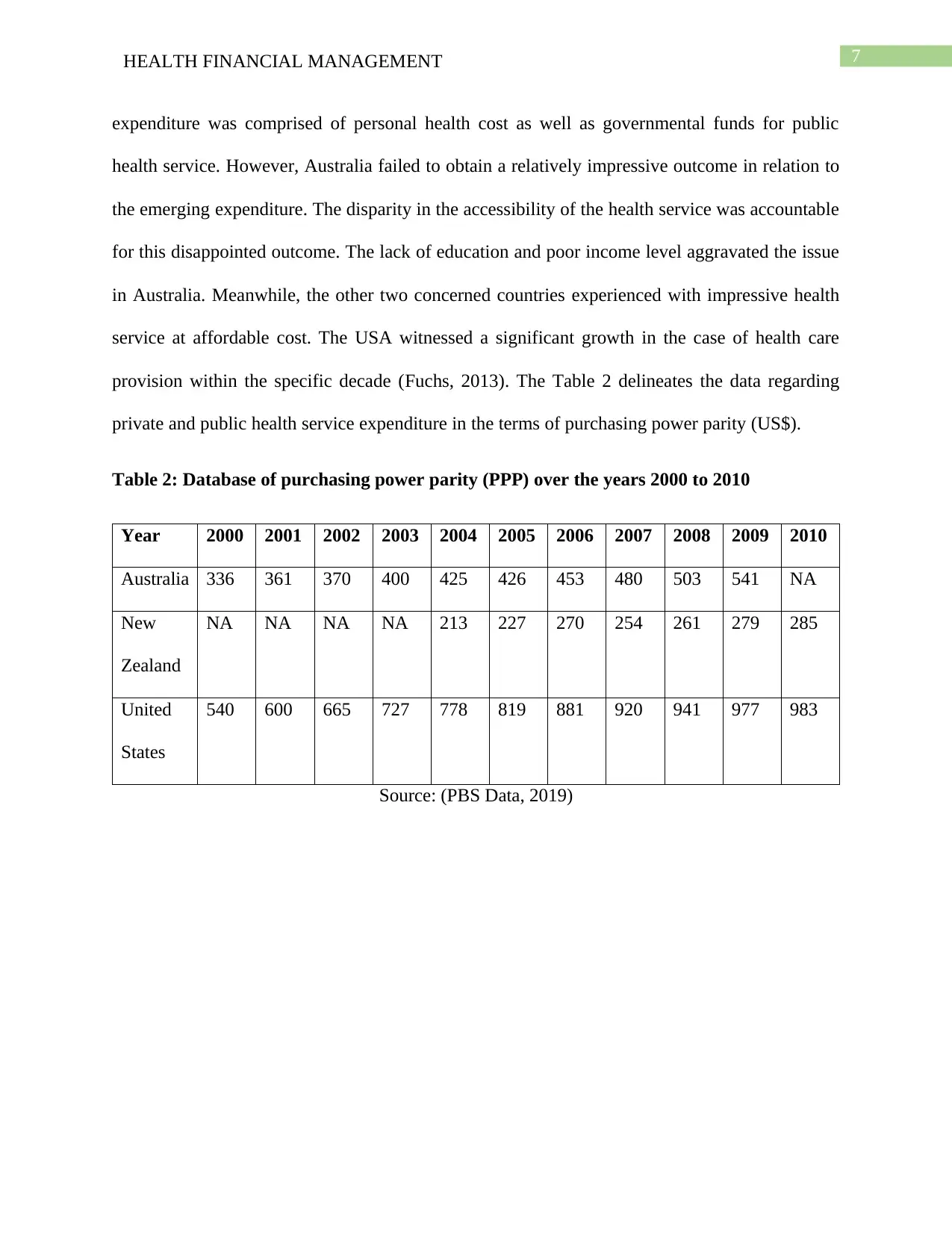
7HEALTH FINANCIAL MANAGEMENT
expenditure was comprised of personal health cost as well as governmental funds for public
health service. However, Australia failed to obtain a relatively impressive outcome in relation to
the emerging expenditure. The disparity in the accessibility of the health service was accountable
for this disappointed outcome. The lack of education and poor income level aggravated the issue
in Australia. Meanwhile, the other two concerned countries experienced with impressive health
service at affordable cost. The USA witnessed a significant growth in the case of health care
provision within the specific decade (Fuchs, 2013). The Table 2 delineates the data regarding
private and public health service expenditure in the terms of purchasing power parity (US$).
Table 2: Database of purchasing power parity (PPP) over the years 2000 to 2010
Year 2000 2001 2002 2003 2004 2005 2006 2007 2008 2009 2010
Australia 336 361 370 400 425 426 453 480 503 541 NA
New
Zealand
NA NA NA NA 213 227 270 254 261 279 285
United
States
540 600 665 727 778 819 881 920 941 977 983
Source: (PBS Data, 2019)
expenditure was comprised of personal health cost as well as governmental funds for public
health service. However, Australia failed to obtain a relatively impressive outcome in relation to
the emerging expenditure. The disparity in the accessibility of the health service was accountable
for this disappointed outcome. The lack of education and poor income level aggravated the issue
in Australia. Meanwhile, the other two concerned countries experienced with impressive health
service at affordable cost. The USA witnessed a significant growth in the case of health care
provision within the specific decade (Fuchs, 2013). The Table 2 delineates the data regarding
private and public health service expenditure in the terms of purchasing power parity (US$).
Table 2: Database of purchasing power parity (PPP) over the years 2000 to 2010
Year 2000 2001 2002 2003 2004 2005 2006 2007 2008 2009 2010
Australia 336 361 370 400 425 426 453 480 503 541 NA
New
Zealand
NA NA NA NA 213 227 270 254 261 279 285
United
States
540 600 665 727 778 819 881 920 941 977 983
Source: (PBS Data, 2019)
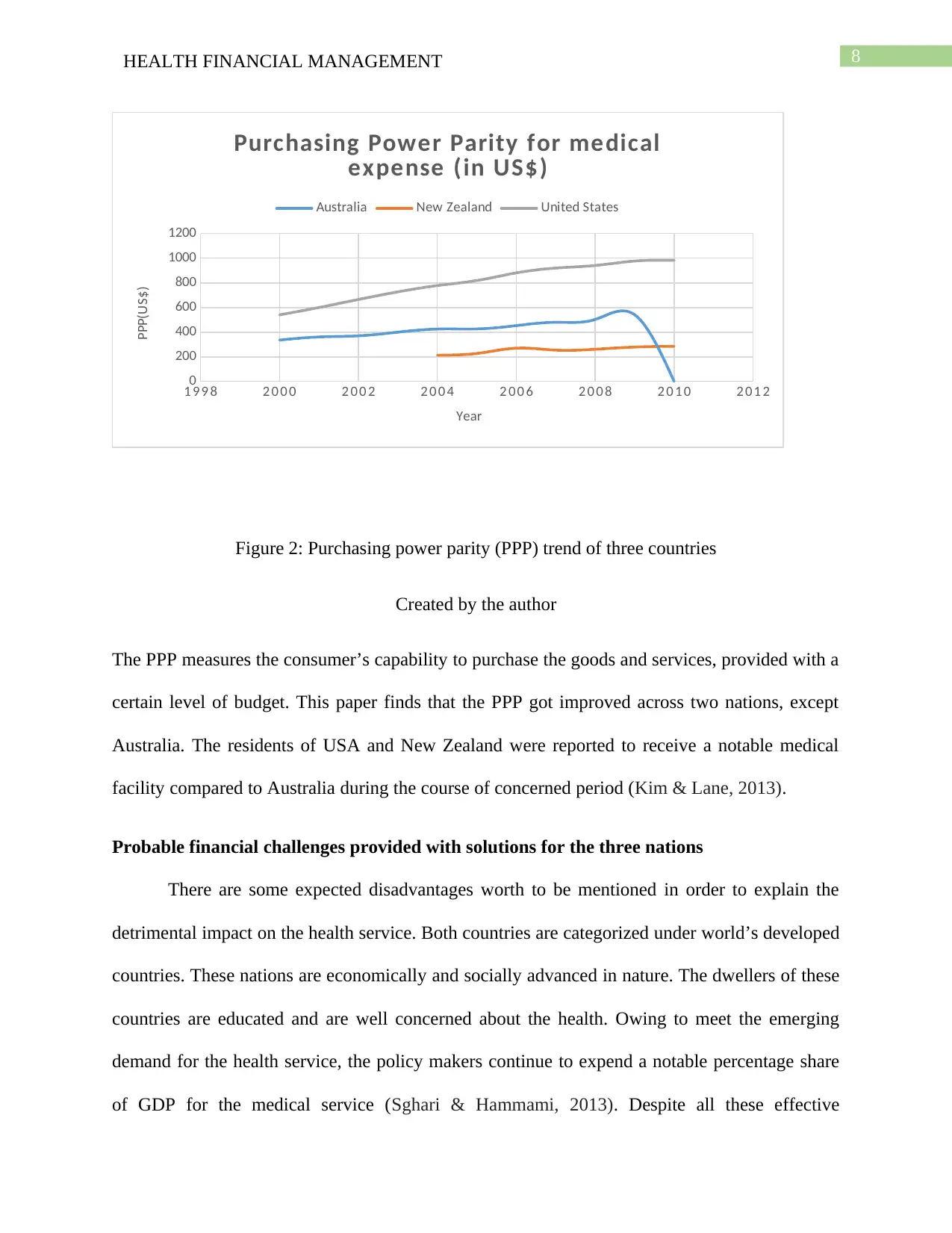
8HEALTH FINANCIAL MANAGEMENT
1 9 9 8 2 0 0 0 2 0 0 2 2 0 0 4 2 0 0 6 2 0 0 8 2 0 1 0 2 0 1 2
0
200
400
600
800
1000
1200
Purchasing Power Parity for medical
expense (in US$)
Australia New Zealand United States
Year
PPP(US$)
Figure 2: Purchasing power parity (PPP) trend of three countries
Created by the author
The PPP measures the consumer’s capability to purchase the goods and services, provided with a
certain level of budget. This paper finds that the PPP got improved across two nations, except
Australia. The residents of USA and New Zealand were reported to receive a notable medical
facility compared to Australia during the course of concerned period (Kim & Lane, 2013).
Probable financial challenges provided with solutions for the three nations
There are some expected disadvantages worth to be mentioned in order to explain the
detrimental impact on the health service. Both countries are categorized under world’s developed
countries. These nations are economically and socially advanced in nature. The dwellers of these
countries are educated and are well concerned about the health. Owing to meet the emerging
demand for the health service, the policy makers continue to expend a notable percentage share
of GDP for the medical service (Sghari & Hammami, 2013). Despite all these effective
1 9 9 8 2 0 0 0 2 0 0 2 2 0 0 4 2 0 0 6 2 0 0 8 2 0 1 0 2 0 1 2
0
200
400
600
800
1000
1200
Purchasing Power Parity for medical
expense (in US$)
Australia New Zealand United States
Year
PPP(US$)
Figure 2: Purchasing power parity (PPP) trend of three countries
Created by the author
The PPP measures the consumer’s capability to purchase the goods and services, provided with a
certain level of budget. This paper finds that the PPP got improved across two nations, except
Australia. The residents of USA and New Zealand were reported to receive a notable medical
facility compared to Australia during the course of concerned period (Kim & Lane, 2013).
Probable financial challenges provided with solutions for the three nations
There are some expected disadvantages worth to be mentioned in order to explain the
detrimental impact on the health service. Both countries are categorized under world’s developed
countries. These nations are economically and socially advanced in nature. The dwellers of these
countries are educated and are well concerned about the health. Owing to meet the emerging
demand for the health service, the policy makers continue to expend a notable percentage share
of GDP for the medical service (Sghari & Hammami, 2013). Despite all these effective
⊘ This is a preview!⊘
Do you want full access?
Subscribe today to unlock all pages.

Trusted by 1+ million students worldwide
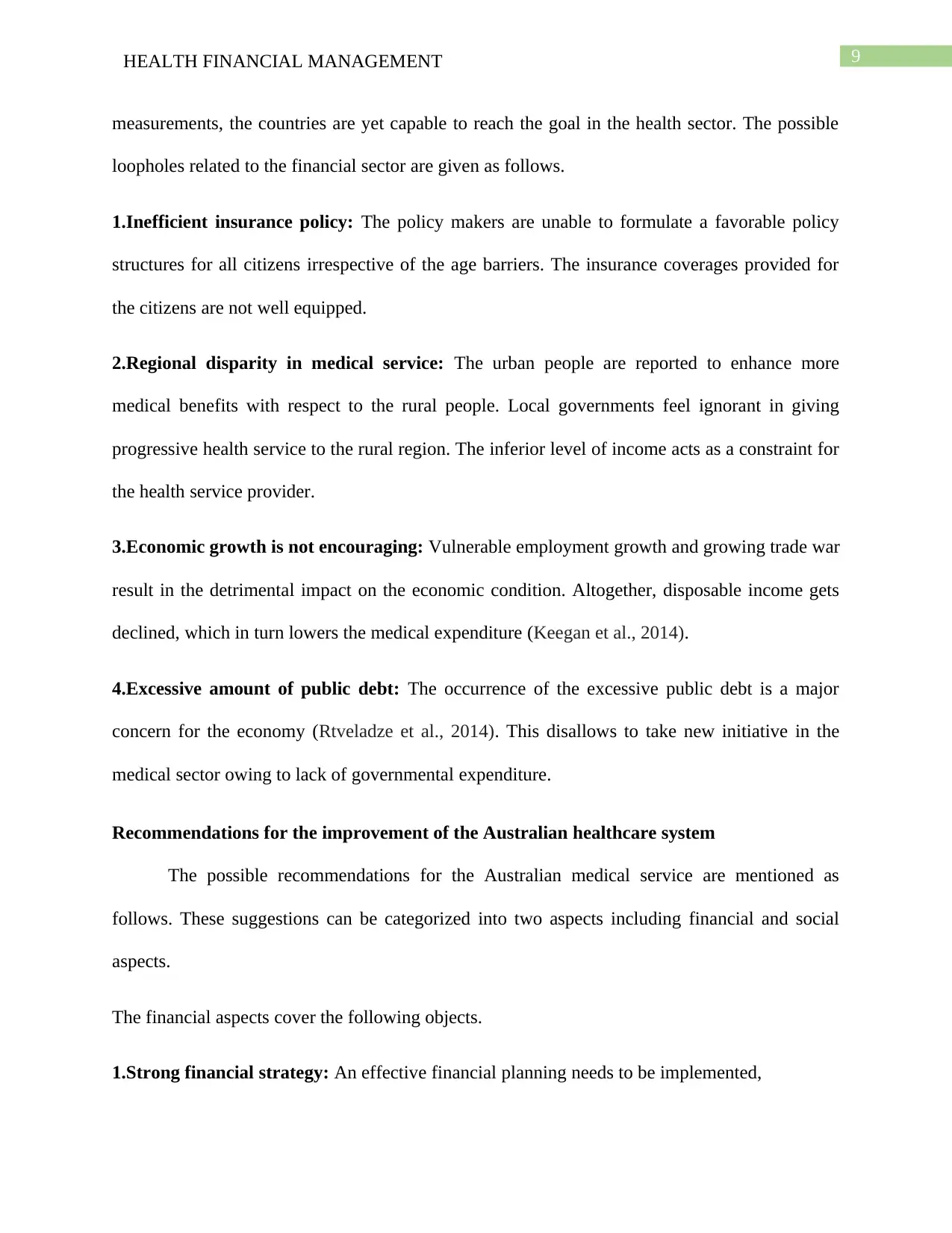
9HEALTH FINANCIAL MANAGEMENT
measurements, the countries are yet capable to reach the goal in the health sector. The possible
loopholes related to the financial sector are given as follows.
1.Inefficient insurance policy: The policy makers are unable to formulate a favorable policy
structures for all citizens irrespective of the age barriers. The insurance coverages provided for
the citizens are not well equipped.
2.Regional disparity in medical service: The urban people are reported to enhance more
medical benefits with respect to the rural people. Local governments feel ignorant in giving
progressive health service to the rural region. The inferior level of income acts as a constraint for
the health service provider.
3.Economic growth is not encouraging: Vulnerable employment growth and growing trade war
result in the detrimental impact on the economic condition. Altogether, disposable income gets
declined, which in turn lowers the medical expenditure (Keegan et al., 2014).
4.Excessive amount of public debt: The occurrence of the excessive public debt is a major
concern for the economy (Rtveladze et al., 2014). This disallows to take new initiative in the
medical sector owing to lack of governmental expenditure.
Recommendations for the improvement of the Australian healthcare system
The possible recommendations for the Australian medical service are mentioned as
follows. These suggestions can be categorized into two aspects including financial and social
aspects.
The financial aspects cover the following objects.
1.Strong financial strategy: An effective financial planning needs to be implemented,
measurements, the countries are yet capable to reach the goal in the health sector. The possible
loopholes related to the financial sector are given as follows.
1.Inefficient insurance policy: The policy makers are unable to formulate a favorable policy
structures for all citizens irrespective of the age barriers. The insurance coverages provided for
the citizens are not well equipped.
2.Regional disparity in medical service: The urban people are reported to enhance more
medical benefits with respect to the rural people. Local governments feel ignorant in giving
progressive health service to the rural region. The inferior level of income acts as a constraint for
the health service provider.
3.Economic growth is not encouraging: Vulnerable employment growth and growing trade war
result in the detrimental impact on the economic condition. Altogether, disposable income gets
declined, which in turn lowers the medical expenditure (Keegan et al., 2014).
4.Excessive amount of public debt: The occurrence of the excessive public debt is a major
concern for the economy (Rtveladze et al., 2014). This disallows to take new initiative in the
medical sector owing to lack of governmental expenditure.
Recommendations for the improvement of the Australian healthcare system
The possible recommendations for the Australian medical service are mentioned as
follows. These suggestions can be categorized into two aspects including financial and social
aspects.
The financial aspects cover the following objects.
1.Strong financial strategy: An effective financial planning needs to be implemented,
Paraphrase This Document
Need a fresh take? Get an instant paraphrase of this document with our AI Paraphraser
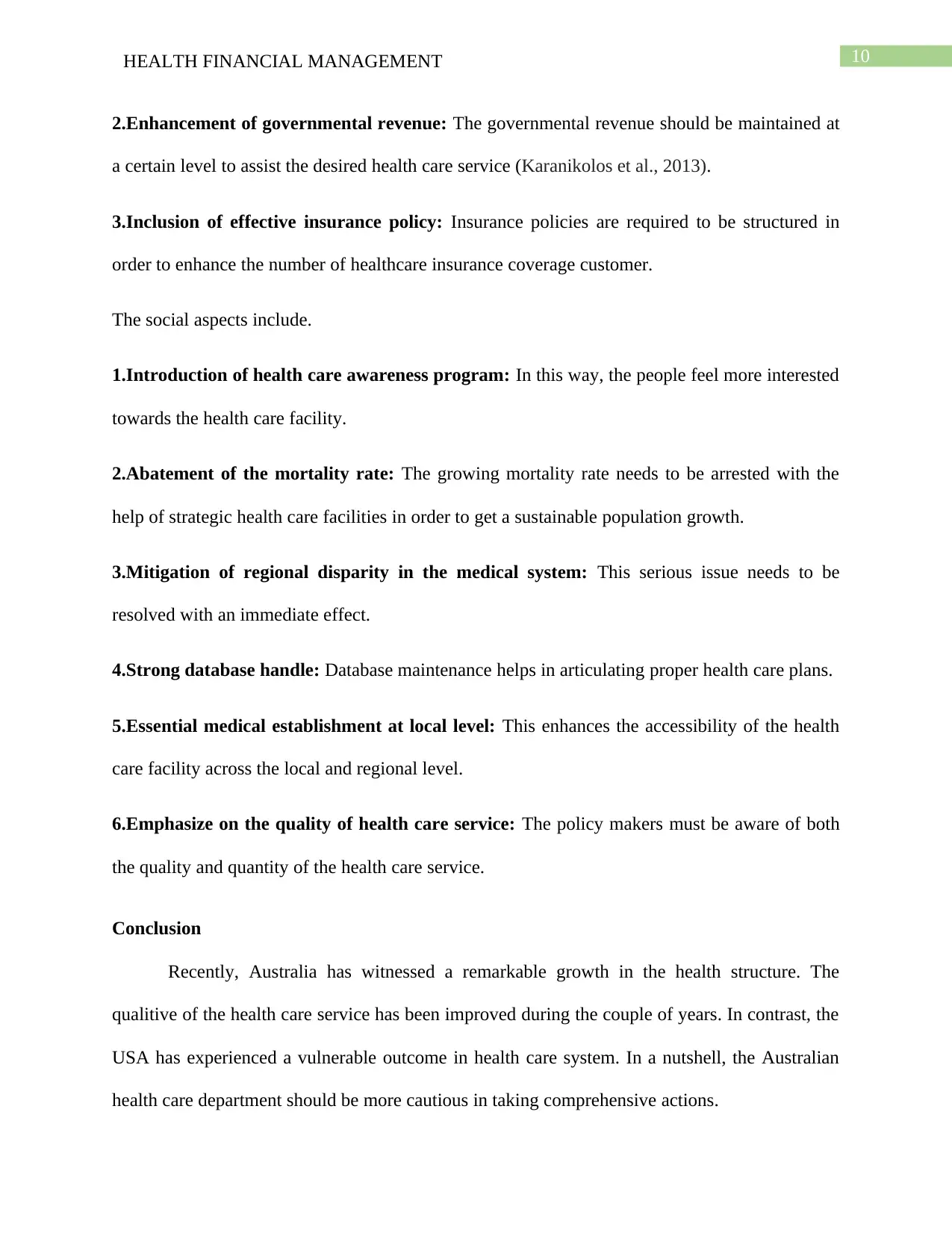
10HEALTH FINANCIAL MANAGEMENT
2.Enhancement of governmental revenue: The governmental revenue should be maintained at
a certain level to assist the desired health care service (Karanikolos et al., 2013).
3.Inclusion of effective insurance policy: Insurance policies are required to be structured in
order to enhance the number of healthcare insurance coverage customer.
The social aspects include.
1.Introduction of health care awareness program: In this way, the people feel more interested
towards the health care facility.
2.Abatement of the mortality rate: The growing mortality rate needs to be arrested with the
help of strategic health care facilities in order to get a sustainable population growth.
3.Mitigation of regional disparity in the medical system: This serious issue needs to be
resolved with an immediate effect.
4.Strong database handle: Database maintenance helps in articulating proper health care plans.
5.Essential medical establishment at local level: This enhances the accessibility of the health
care facility across the local and regional level.
6.Emphasize on the quality of health care service: The policy makers must be aware of both
the quality and quantity of the health care service.
Conclusion
Recently, Australia has witnessed a remarkable growth in the health structure. The
qualitive of the health care service has been improved during the couple of years. In contrast, the
USA has experienced a vulnerable outcome in health care system. In a nutshell, the Australian
health care department should be more cautious in taking comprehensive actions.
2.Enhancement of governmental revenue: The governmental revenue should be maintained at
a certain level to assist the desired health care service (Karanikolos et al., 2013).
3.Inclusion of effective insurance policy: Insurance policies are required to be structured in
order to enhance the number of healthcare insurance coverage customer.
The social aspects include.
1.Introduction of health care awareness program: In this way, the people feel more interested
towards the health care facility.
2.Abatement of the mortality rate: The growing mortality rate needs to be arrested with the
help of strategic health care facilities in order to get a sustainable population growth.
3.Mitigation of regional disparity in the medical system: This serious issue needs to be
resolved with an immediate effect.
4.Strong database handle: Database maintenance helps in articulating proper health care plans.
5.Essential medical establishment at local level: This enhances the accessibility of the health
care facility across the local and regional level.
6.Emphasize on the quality of health care service: The policy makers must be aware of both
the quality and quantity of the health care service.
Conclusion
Recently, Australia has witnessed a remarkable growth in the health structure. The
qualitive of the health care service has been improved during the couple of years. In contrast, the
USA has experienced a vulnerable outcome in health care system. In a nutshell, the Australian
health care department should be more cautious in taking comprehensive actions.
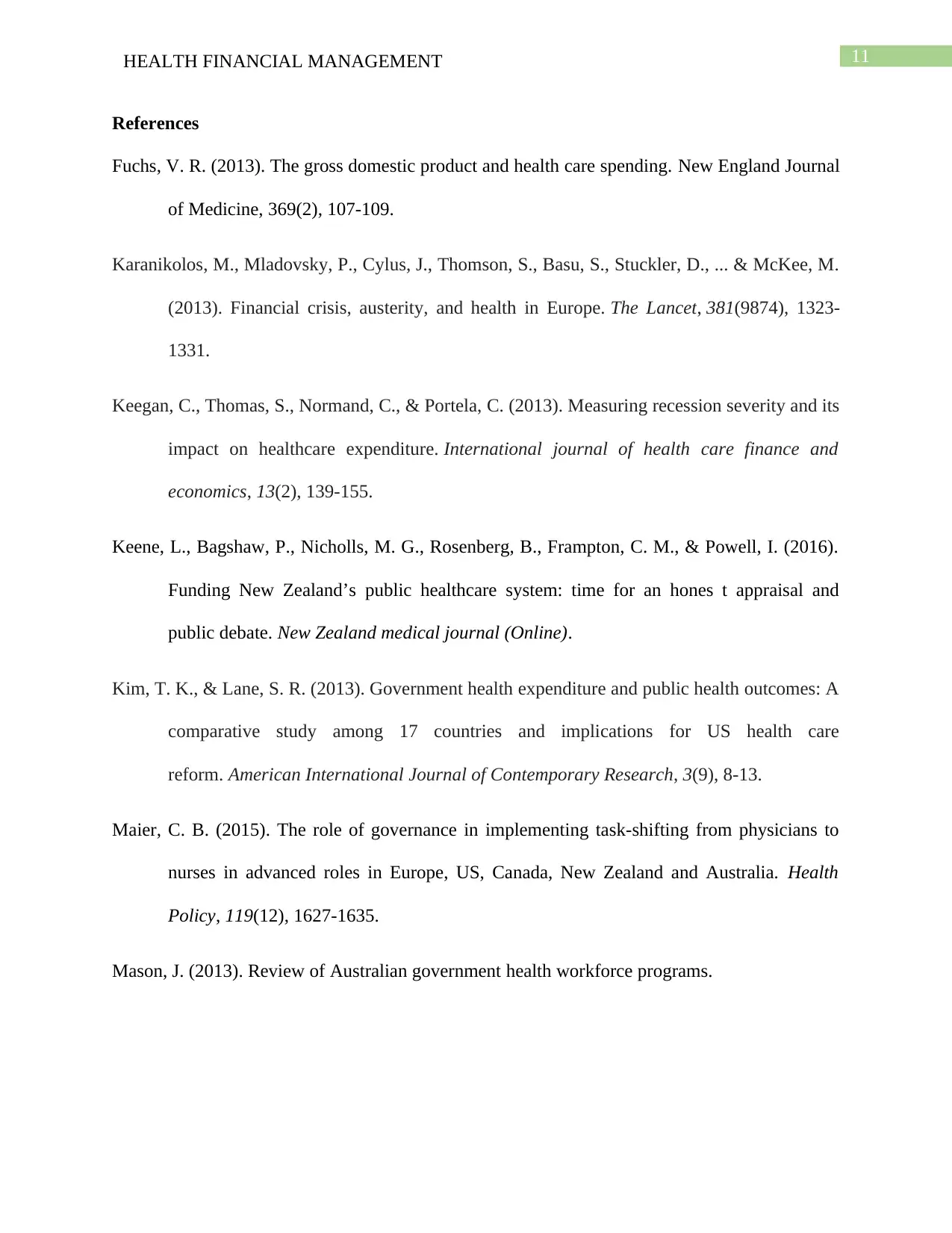
11HEALTH FINANCIAL MANAGEMENT
References
Fuchs, V. R. (2013). The gross domestic product and health care spending. New England Journal
of Medicine, 369(2), 107-109.
Karanikolos, M., Mladovsky, P., Cylus, J., Thomson, S., Basu, S., Stuckler, D., ... & McKee, M.
(2013). Financial crisis, austerity, and health in Europe. The Lancet, 381(9874), 1323-
1331.
Keegan, C., Thomas, S., Normand, C., & Portela, C. (2013). Measuring recession severity and its
impact on healthcare expenditure. International journal of health care finance and
economics, 13(2), 139-155.
Keene, L., Bagshaw, P., Nicholls, M. G., Rosenberg, B., Frampton, C. M., & Powell, I. (2016).
Funding New Zealand’s public healthcare system: time for an hones t appraisal and
public debate. New Zealand medical journal (Online).
Kim, T. K., & Lane, S. R. (2013). Government health expenditure and public health outcomes: A
comparative study among 17 countries and implications for US health care
reform. American International Journal of Contemporary Research, 3(9), 8-13.
Maier, C. B. (2015). The role of governance in implementing task-shifting from physicians to
nurses in advanced roles in Europe, US, Canada, New Zealand and Australia. Health
Policy, 119(12), 1627-1635.
Mason, J. (2013). Review of Australian government health workforce programs.
References
Fuchs, V. R. (2013). The gross domestic product and health care spending. New England Journal
of Medicine, 369(2), 107-109.
Karanikolos, M., Mladovsky, P., Cylus, J., Thomson, S., Basu, S., Stuckler, D., ... & McKee, M.
(2013). Financial crisis, austerity, and health in Europe. The Lancet, 381(9874), 1323-
1331.
Keegan, C., Thomas, S., Normand, C., & Portela, C. (2013). Measuring recession severity and its
impact on healthcare expenditure. International journal of health care finance and
economics, 13(2), 139-155.
Keene, L., Bagshaw, P., Nicholls, M. G., Rosenberg, B., Frampton, C. M., & Powell, I. (2016).
Funding New Zealand’s public healthcare system: time for an hones t appraisal and
public debate. New Zealand medical journal (Online).
Kim, T. K., & Lane, S. R. (2013). Government health expenditure and public health outcomes: A
comparative study among 17 countries and implications for US health care
reform. American International Journal of Contemporary Research, 3(9), 8-13.
Maier, C. B. (2015). The role of governance in implementing task-shifting from physicians to
nurses in advanced roles in Europe, US, Canada, New Zealand and Australia. Health
Policy, 119(12), 1627-1635.
Mason, J. (2013). Review of Australian government health workforce programs.
⊘ This is a preview!⊘
Do you want full access?
Subscribe today to unlock all pages.

Trusted by 1+ million students worldwide
1 out of 13
Related Documents
Your All-in-One AI-Powered Toolkit for Academic Success.
+13062052269
info@desklib.com
Available 24*7 on WhatsApp / Email
![[object Object]](/_next/static/media/star-bottom.7253800d.svg)
Unlock your academic potential
Copyright © 2020–2025 A2Z Services. All Rights Reserved. Developed and managed by ZUCOL.





